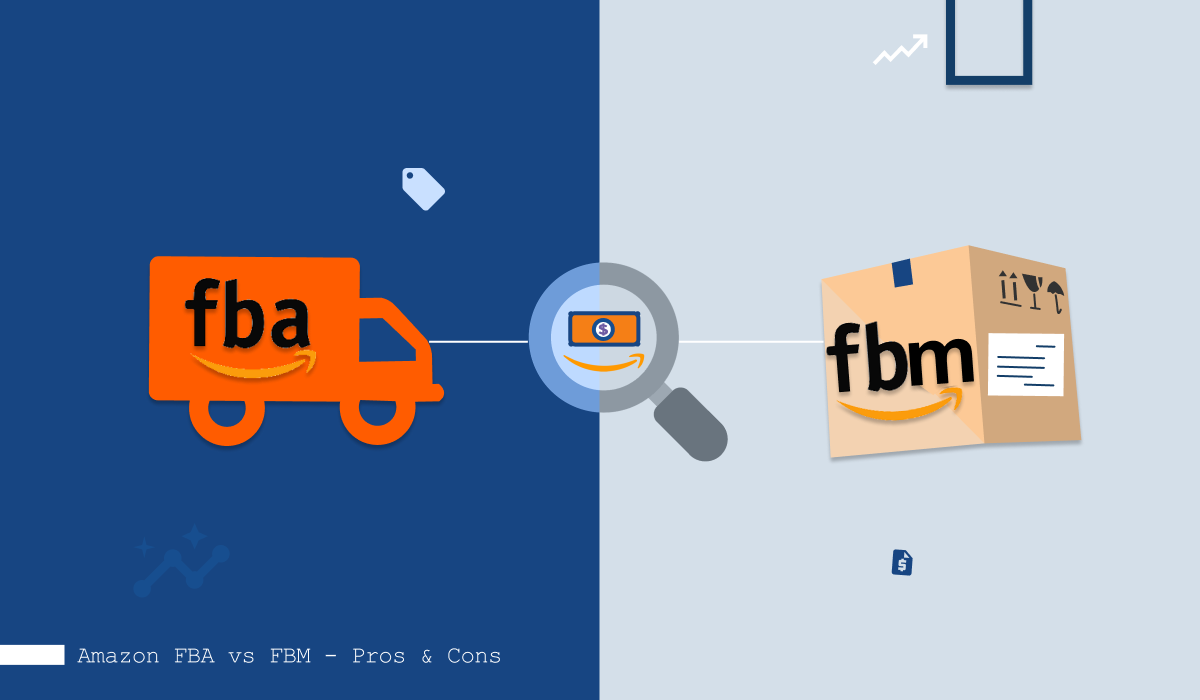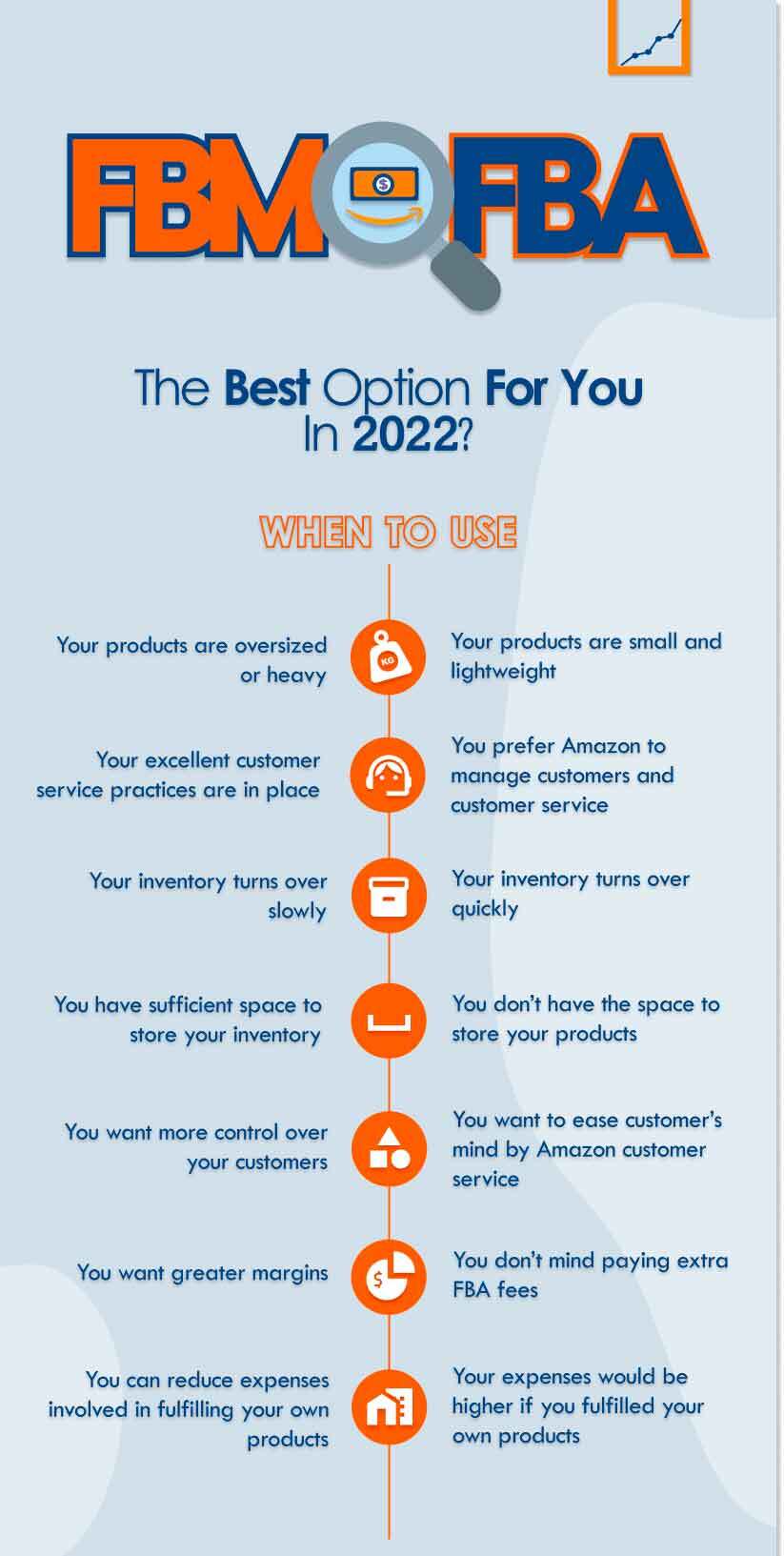
Fulfilled By Amazon (FBA) is a popular program on Amazon but with its fees being high, Fulfilled By Merchant (FBM) becomes a relevant alternative with its own pros and cons.
With FBA, the seller sends their products to an Amazon fulfillment center and Amazon takes care of storage, packaging, and shipping on behalf of the seller. This fulfillment method takes the burden off of sellers, allowing them to focus more on scaling their business.
Amazon introduced FBA on September 19th, 2006 in order to enable sellers to use Amazon’s own order fulfillment infrastructure. After FBA was launched in 2006, the volume of sales increased significantly and it attracted more third-party sellers to Amazon.
Over the years, Amazon has continuously improved the fulfillment method to make it convenient for sellers and buyers. FBA is certainly one of the factors that have contributed to the massive growth of Amazon.
FBA vs FMB infographic: which is best for you at a glance

FBM is a self-fulfillment option whereby the seller handles the entire process, from purchasing to storage, packaging, shipping, and customer service.
Unlike with FBA whereby the seller pays a fee to Amazon so that they can handle everything on their behalf, FBM gives the seller full control of the entire process. The seller uses their own resources to store, pack, and ship orders.
Understanding the differences between Amazon FBA and FBM as well as the pros and cons of each fulfillment method will help you choose the option that makes sense for your business.
Choosing the right fulfillment method can be difficult when you don’t understand the differences, costs, pros, and cons of each method. A comparison between the two will take the hassle out of making a choice and ensure you choose a profitable fulfillment method.
In this blog post, we’ll provide you with a full comparison between Amazon FBA and FBM. Read on to learn more.
FBA vs FBM: getting to know each program
It’s no surprise that most sellers default to using FBA as their sales method on Amazon compared to FBM. There are so many reasons to like FBA:
- Buy Box eligibility: the Amazon Buy Box is the “Add to Cart” or “Buy Now” white box displayed on the right side of the product detail page. One of the easiest ways to win the Buy Box is enrolling for Amazon FBA. Typically, FBA sellers are more likely to appear in the Buy Box. Having the Amazon Buy Box gives you more visibility on the marketplace and builds your credibility which increases your chances of making more sales.
- The Amazon Prime badge: enrolling for FBA gives you access to Amazon Prime which means your product listings will be displayed with the Prime logo. Amazon Prime offers free, one-day, or two-day shipping for eligible purchases. This allows Prime sellers to attract customers looking for free one-or two-day shipping. With close to 112 million people on Prime, the badge puts your products in front of a larger audience. This increases your chances of making more sales.
- Brand Building is more attainable: FBA sellers have more chances of ranking higher in Amazon’s search results. Therefore, using fulfillment-by-Amazon will make your products more visible. In addition, Amazon shoppers tend to trust FBA sellers more because Amazon takes care of the entire process. By enrolling for Amazon FBA, you’ll give your business more credibility.
However, you have to remember that Amazon wants to make a profit out of literally every program they offer both to sellers and customers on their platform. That’s why they charge a fee for their selling plans.
Amazon offers the professional selling plan at a cost of $39.99 per month regardless of the number of items you sell plus a per-item referral fee. The individual selling plan costs $0.99 per unit sold—which means you’ll pay $0.99 every time you make a sale plus a per-item referral fee, which is a percentage of the total transaction.
Amazon also makes money through Amazon Prime membership whereby they charge $119 as subscription fees.
Challenges with selling FBA
If you’re an FBA seller, there are certain fees you have to pay in order to sell on Amazon. The fees you’ll pay will depend on your selling plan, product category, and other factors. Amazon charges all sellers a nominal fee of 15% of the product’s selling price on each product sold.
So, this is the first way Amazon makes money off of FBA. Apart from the 15% seller fee, Amazon charges fulfillment fees which are based on the size and weight of the product; and inventory storage fees which is basically the fee sellers pay for storing their inventory at Amazon’s fulfillment centers.
Fulfillment fees include the entire picking, packing, and shipping process for each order shipped. FBA inventory storage fees are based on the average space your inventory occupies in fulfillment centers. There is also a referral fee for each item sold.
This will depend on the product category and usually ranges from 8% to 15%. The Other fees FBA sellers may incur include product return fees, inventory removal fees, penalty fees, and package preparation fees.
Challenges with selling FBM
As an FBM seller on Amazon, there are certain fees you must pay in order to use the fulfillment method. These include a monthly subscription fee ($39.99), a fee for each item sold ($0.99), and referral fees (typically ranges from 6% to 45% based on product category).
If you partner with a third-party to handle Amazon FBM, you’ll also incur storage and fulfillment costs. So the difference between FBA and FBM in terms of fees is that FBA sellers pay order fulfillment fees, monthly storage fees, and long-term storage fees while FBM sellers don’t pay these fees because they take care of fulfillment and storage on their own.
Understanding the costs associated with each fulfillment method will help you choose the best option that will work for you. However, you must also know the differences between the two to be able to make an informed choice. In this next section, we’ll look at how the two compare.
Fulfilled By Amazon (FBA) recap
FBA’s main aspect lies in its name: you send your inventory directly to Amazon and they manage end-customer shipments on your behalf. Amazon’s staff will pick, pack, and ship your products to customers as orders come in. They will also handle customer service tasks including returns and refunds.
Amazon deposits sales profit in sellers’ accounts every two weeks. Amazon FBA is ideal if your items have a fast turnover and your items are small or expensive. FBA is also recommended for sellers who don’t have the manpower to fulfill orders efficiently.
When you use FBA, Amazon charges you a fulfillment fee and a monthly storage fee which is calculated based on a range of factors.
Fulfilled By Merchant (FBM) recap
FBM is another story as it puts all the responsibility on you—the seller—for both inventory management and customer shipments. With FBM, you list your products on Amazon but you take care of the entire handling process and shipping.
Instead of paying Amazon, you’ll use your own resources to store, package, and ship orders directly to buyers. So, Amazon only provides you with a platform to list your products, and you handle everything else by yourself.
Fulfilled-by-Merchant is recommended for sellers who sell items that are large or heavy or products that don’t have a fast turnover.
To create an FBM listing, you’ll simply need to create a regular product listing and select “I will ship the item myself” in the Fulfillment Channel section.
Choosing one program over the other leads to completely different business models so you have to consider the pros and cons of FBA vs FBM closely.
FBA & FBM comparison: the pros & cons
To illustrate the advantages of FBA over FBM and vice versa, we will focus on 3 key areas that make for the bulk of these programs.
1. Order fulfillment
Order fulfillment for FBA works in a very straightforward way. You send the inventory listed on your Seller Central account to Amazon FBA and Amazon stores the inventory for you. When a customer places an order for any of your items, Amazon will pick and pack the product, then ship it to the customer.
With FBA, Amazon takes full responsibility for the storage, packaging, shipping, and customer service. Your role as an FBA seller is to choose your products, ensure your inventory is always up to date, and create a compelling product listing.
On the other hand, Fulfillment-by-Merchant puts the seller in control of their entire handling and shipping process. FBM sellers use Amazon as a listing venue, but they handle everything else on their own.
Advantages of Amazon FBA in terms of order fulfillment include:
- Takes the burden off of sellers;
- Guarantees customers of order delivery—this helps to build trust;
- Allows you to focus on growing your business.
Cons:
- Comes at a fee;
- No control over fees;
- Off-brand packaging;
2. Costs
Fulfillment cost is another factor that brings out the difference between FBA and FBM. FBA sellers pay order fulfillment fees, monthly storage fees, and long-term storage fees (applies to inventory that has been in a fulfillment center for more than 365 days).
FBM sellers do not pay this kind of fee to Amazon because they handle their fulfillment and storage on their own. However, both FBA and FBM sellers will pay a monthly subscription fee, referral fee, and a fee for each item sold.
Advantages of Amazon FBA in terms of cost:
- Gives you automatic Prime eligibility, which saves you money
- The monthly subscription cost is affordable
- Overheads are significantly reduced
Cons:
- Extra shipping costs
- Long-term storage fees
3. Seller fulfillment capabilities
FBA is recommended for sellers who don’t have what it takes to fulfill orders efficiently and provide the best customer service. So they’ll prefer to pay a fee so that Amazon can manage the whole process on their behalf. It’s also ideal for items with fast turnover, lightweight, and expensive items.
FBA is a good choice for a seller who wants to make more sales and establish credibility. FBM is a better idea if a seller has enough manpower and storage space to manage their inventory efficiently and provide efficient customer support. This fulfillment method is also preferred by sellers dealing with big, heavy, and cheap items.
Armed with comparisons in each of these areas, you should have a good understanding of which program is best for your business development on Amazon.
Advantages of Amazon FBA in terms of seller fulfillment capabilities:
- Gives you the flexibility to choose what works best for you
- Sellers without storage can use Amazon’s fulfillment centers
Cons:
- Forfeiting control
- Product handling issues with Amazon
Which seller types use FBA vs FBM?
Of course, every industry will have its own way of handling these areas. Here’s a breakdown of various industries that use FBA or FBM in their own unique ways:
| Lifestyle | FBA |
| Consumer electronics | FBM |
| Beauty and personal care | FBA |
| Fashion | FBA |
| Sports and outdoors | FBM |
| Toys and games | FBM |
The lifestyle, fashion and beauty, and personal care use FBA to ensure quick delivery while the sports and outdoors and toys and games categories prefer FBM to cut down on shipping charges and save money on storage fees.
Emplicit can guide you to the right program for your brand
While FBA is the default for many brands on Amazon, FBM does make sense in many cases. The truth is in how you are going to make use of the programs.
Each Amazon brand is unique in various aspects which means you must put an effort to differentiate your brand. Emplicit can help your brand stand out from the competition and will including FBA or FBM as part of our strategic recommendations.
Emplicit is a leading results-driven Amazon marketing agency for growing ecommerce brands. Tap into our managed services to take your ecommerce or Amazon business to the next level today.

